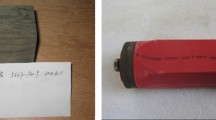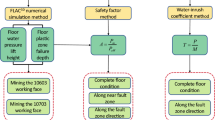Abstract
This paper presents underground measurements (e.g., mini-frac tests) for in situ stress, hydraulic fractures, strata failures and hydraulic conductivity enhancement induced by coal extraction to study mechanisms of coal mine water inrushes. Mining perturbs the original state of in situ stress and results in stress redistribution. This causes rock failures and creates a water-conducting failure zone around a mining panel. If a confined aquifer is situated in the coal seam floor, the mining-induced stresses near the aquifer also generate hydraulic fractures in the rocks near to the aquifer. The mining-induced water-conducting failures and hydraulic fractures by the water pressure of the aquifer are the major reasons to cause water inrushes. The mining-induced water-conducting zone is obtained from theoretical studies and field measurements. The generating condition of the hydraulic fractures by the water pressure is also studied. Methods for predicting water inrushes are given based on the study of water inrush mechanisms. The mechanisms of water inrushes induced by faults are also analyzed from the case studies of water inrushes. It is of crucial importance to detect and map faults, paleo-sinkhole and other geological structures before mining. New mining methods are proposed for mining near confined aquifers to reduce the risks of water inrushes.


















Similar content being viewed by others
References
Detournay E, Cheng AH-D (1988) Poroelastic response of a borehole in a non-hydrostatic stress field. Int J Rock Mech Min Sci Geomech Abstr 25:171–182
Gao Y, Li B (1992) Study on coal seam floor deformation and failure induced by mining faces threatened by Ordovician limestone confined aquifer. J China Coal Soc 17(2):33–38 [in Chinese]
Guo H, Adhikary DP, Craig MS (2009) Simulation of mine water inflow and gas emission during longwall mining. Rock Mech Rock Eng 42(6):911–930
Haimson BC, Cornet FH (2003) ISRM suggested methods for rock stress estimation—part 3: hydraulic fracturing (HF) and/or hydraulic testing of pre-existing fractures (HTPF). Int J Rock Mech Min Sci 40:1011–1020
Haimson BC, Fairhurst C (1967) Initiation and extension of hydraulic fractures in rocks. SPE J 7:310–318
Hubbert MK, Willis DG (1957) Mechanics of hydraulic fracturing. Trans. ASME 210:153–166
Li J (1990) Control of coal mine karst aquifers. Coal Industry Publ Press, Beijing [in Chinese]
Ma D, Bai H, Wang Y (2015) Mechanical behavior of a coal seam penetrated by a karst collapse pillar: mining-induced groundwater inrush risk. Nat Hazards 75:2137–2151
Meng Z, Zhang J, Wang R (2011) In-situ stress, pore pressure and stress-dependent permeability in the Southern Qinshui Basin. Int J Rock Mech Min Sci 48:122–131
Peng S, Zhang J (2007) Engineering geology for underground rocks. Springer, New York
Wu Q (2014) Progress, problems and prospects of prevention and control technology of mine water and reutilization in China. J China Coal Soc 39(5):795–805
Wu Q, Wang M, Wu X (2004) Investigations of groundwater bursting into coal mine seam floors from fault zones. Int J Rock Mech Min Sci 41:557–571
Xiao HT, Xu HY (2000) In situ permeability measurements to establish the influence of slice mining on floor rocks. Int J Rock Mech Min Sci 2000(37):855–860
Xu Y, Li J, Liu B (2014) Reinforcement of working face by grouting in floor in Jiaozuo coal mining area. Coal Geol Explor 42(4):50–54 [in Chinese]
Yang T, Tang CA, Tan Z, Zhu W, Feng Q (2007) State of the art of inrush models in rock mass failure and developing trend for prediction and forecast of groundwater inrush. Chin J Rock Mech Eng 26(2):268–277 [in Chinese]
Yin S, Wang S, Wu Q (2003) Characteristics of Karstic collapse columns in north coalfields of china and mechanism of water inrush from coal seam floor. In: Rock Stress. 3rd Int Symp Rock Mech, Kumamoto, Japan. A. A. Balkema, Rotterdam, pp 517–522
Yin S (2009) Models and mechanisms of water inrushes from coal seam floor. J Xia’an Univ Sci Technol 29(6):661–665 [in Chinese]
Yin S, Wu Q (2004) Simulation and mechanism analysis of water inrush from karstic collapse columns in coal floor. Chin J Rock Mech Eng 23(15):2551–2557 [in Chinese]
Yin S, Zhang J (2005) Impacts of karst paleo-sinkholes on mining and environment in northern China. Environ Geol 48:1077–1083
Zhang J (1989) Theory and practice on prediction of water inrushes from coal seam floor. Coal Geol Explor 4:38–41 [in Chinese]
Zhang J (2005) Investigations of water inrushes from aquifers under coal seams. Int J Rock Mech Min Sci 42(3):350–360
Zhang J (2011) Pore pressure prediction from well logs: methods, modifications, and new approaches. Earth Sci Rev 108:50–63
Zhang J (2013) Borehole stability analysis accounting for anisotropies in drilling to weak bedding planes. Int J Rock Mech Min Sci 60:160–170
Zhang J, Liu T (1990) On depth of fissured zone in seam floor resulted from coal extraction and its distribution characteristics. J China Coal Soc 15(2):46–55 [in Chinese]
Zhang J, Roegiers J-C (2010) Discussion on “integrating borehole-breakout dimensions, strength criteria, and leak-off test results, to constrain the state of stress across the Chelungpu Fault, Taiwan”. Tectonophysics 492:295–298
Zhang J, Shen B (2004) Coal mining under aquifers in China: a case study. Int J Rock Mech Min Sci 41(4):629–639
Zhang J, Zhang Y, Liu T (1997) Rock mass permeability and coal mine water inrush. Geological Publ House, Beijing [in Chinese]
Zhang J, Roegiers J-C, Bai M, Zhang Y (2001) Stress-dependent permeability variation and mine subsidence, In: 38th U.S. Rock Mechanics Symposium, Washington DC, Balkema, Rotterdam
Zhang J, Standifird W, Roegiers J-C, Zhang Y (2007) Stress-dependent fluid flow and permeability in fractured media: from lab experiments to engineering applications. Rock Mech Rock Eng 40(1):3–21
Zhang R, Jiang Z, Zhou H, Yang C, Xiao S (2014) Groundwater outbursts from faults above a confined aquifer in the coal mining. Nat Hazards 71:1861–1872
Acknowledgments
This work was supported by the National “Twelfth Five-Year” Plan for Science and Technology Support (2012BAK04B04), National Science Foundation of China (51074075) and Hebei Natural Science Foundation (E2012508001). We thank Feicheng coal mine for providing the test site and supporting the underground test.
Author information
Authors and Affiliations
Corresponding author
Rights and permissions
About this article
Cite this article
Yin, S., Zhang, J. & Liu, D. A study of mine water inrushes by measurements of in situ stress and rock failures. Nat Hazards 79, 1961–1979 (2015). https://doi.org/10.1007/s11069-015-1941-1
Received:
Accepted:
Published:
Issue Date:
DOI: https://doi.org/10.1007/s11069-015-1941-1




